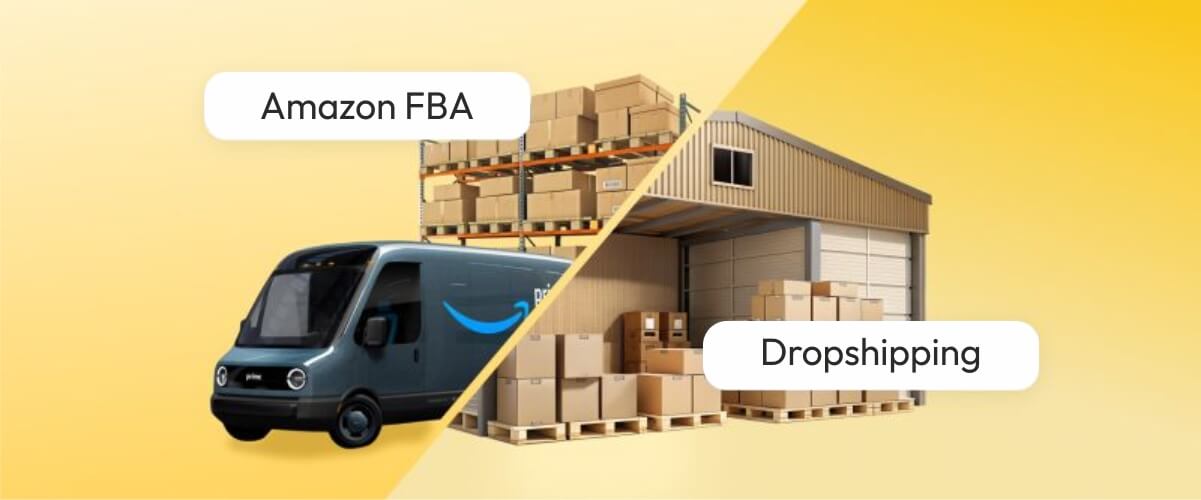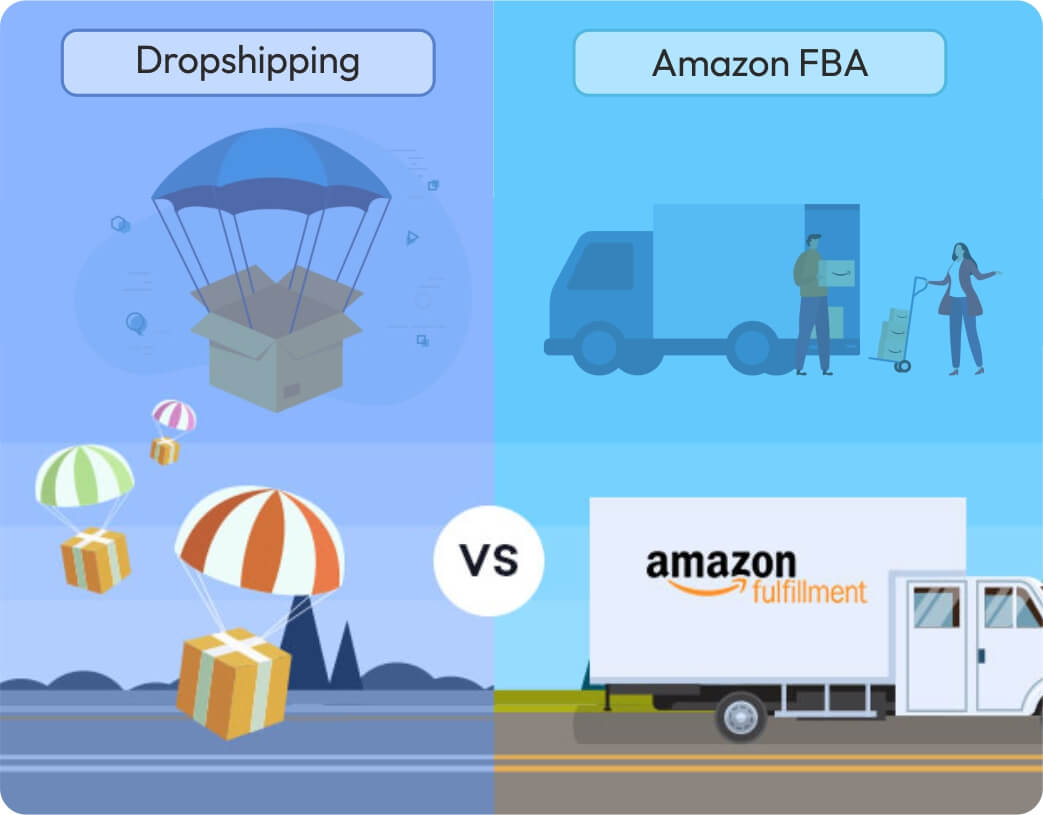- GF/ SF - Tejas, Opp Hotel Prasadalay, Shukrawar Peth, Pune - 411002
- +91 90 2132 2132
Amazon FBA vs Dropshipping: Which is the Better Business Model for You?

Amazon FBA (Fulfillment by Amazon) vs. dropshipping. They both form part of the popular e-commerce models that present unique opportunities for an entrepreneur using them. The best part? They enable one to sell products on an Internet platform while hardly ever having to consider handling inventory directly. But, each one comes with its own set of pros and cons.
Whether you prefer that things get done with little input from you or you want complete control over the products themselves, the choice of model does matter. In this blog, we will take apart what each model is about, the differences, point out the key features, and help you decide which one fits best with your business objectives.
What is Amazon FBA?
In the FBA (Fulfillment by Amazon), sellers utilize Amazon's fulfillment centers, where Amazon picks, packs, ships, and handles customer service. This takes advantage of Amazon's superior inventory management and shipping systems that provide timely deliveries and hassle-free return processing.
The sellers' choice of a fulfillment method is Amazon FBA, where 89% use it. Whether for private-label products or retail arbitrage or wholesale reselling, FBA provides an easy way to run any business, knowing it is backed by the power of Amazon's name.
Key Features of Amazon FBA:
- Storage & Order Fulfillment: Amazon stores your products and picks, packs, and ships them for you.
- Customer Service & Returns: Amazon can monitor customer relations, taking care of customer support and returns on your behalf.
- Prime Eligibility: Products labeled with "Amazon Prime" ship in a lightning-fast manner and have better visibility.
- Multi-Channel Fulfillment: You can also have orders placed on other websites fulfilled by Amazon fulfillment services.
The Key What is Dropshipping?
One of the greatest characteristics of dropshipping is that you do not need to worry about holding inventory. You only need to list a product, and it is shipped directly from the supplier to the customer. Thus, it is common on Amazon, eBay, and Shopify because it does not require much investment.
If you are an Amazon seller, there are some rules to follow concerning purchasing products not directly from retail sources like Walmart and ensuring that all your invoices and packages carry your name. It is a flexible system in that it allows you to try different products without worrying much about stock.
Key Features of Dropshipping
- No Inventory Management: Not having to stock, buying in bulk reduces startup costs even more.
- Flexibility: You can sell products from multiple suppliers without worrying about how many products you have in stock.
- Low Overhead: You do not have to buy and store products, so much lower overhead costs would be incurred.
- Lower Profit Margin: Since you are using someone else's services for everything, unit costs are usually higher, hence leading to thinner profit margins.
Amazon FBA vs Dropshipping: A Comparison

-
Startup Costs
Amazon FBA: The investment is slightly on the higher side here, as you will have to buy the inventory at the beginning and then send it to the Amazon warehouse. But the more investment in the beginning will get you the best possible returns on your investment, once the products start selling.
Dropshipping: You don't want to buy the whole inventory, so the model is an easy start for beginners. Expect to pound out the expense, to bring potential customers through traffic to your site, especially when you compete with other dropshippers.
-
Control Over Products
Amazon FBA: The benefit of selling products is that you get to choose whom you deal with and what quality of product you want.
Dropshipping: As third-party suppliers are responsible for fulfilling your orders, your control over product quality is limited. This could sometimes lead to customer dissatisfaction when the product does not meet expectations.
-
Profit Margins
Amazon FBA: The costs of using Amazon’s platform, including storage fees, shipping fees, and other costs, can reduce your profit margins. However, the complete size of Amazon's marketplace and its ease of use can offset those costs for you when you have a high volume of sales.
Dropshipping: Low profit margin is usually because of the supplier pricing of the product and extra costs which can include handling and freight. But your initial investment turns out to be very low because you do not have any inventory with you.
-
Shipping and Customer Service
Amazon FBA: The big one was that Amazon took over everything from shipping to returns to customer service. It scales up effortlessly through an amazing logistics system and world presence, with probably even more profit potential.
Dropshipping: Your suppliers take care of shipping, while you get the benefit of relying on them to ship products on time. If there is a delay, it is your responsibility to handle communication with the customer and work toward a solution.
-
Marketing and Visibility
Amazon FBA: Amazon's marketplace is full of active shoppers buying millions of products that can potentially pull traffic to yours. However, the competition is quite intense, and you may need to consider advertising to get some visibility.
Dropshipping: What you need to do is create a website that you want, and create traffic through ads, SEO, or social media. The ease of relaxation here is that you are starting with the basics; however, Amazon has built-in traffic. However, it allows more freedom for you in developing your own brand and marketing strategy.
Which Model Should You Choose?
The choice between Amazon FBA and dropshipping is based on one's aims for their business, budgetary status, and preferred level of engagement.
-
Choose Amazon FBA if:
You possess a more extensive budget and are willing to invest up front in inventory.
You desire that Amazon manage everything from shipping to customer service and returns.
You're looking to scale quickly with Amazon's international marketplace and logistics systems.
-
Choose Dropshipping if:
Having a limited budget and preferring low-risk, low-cost methods of entry into e-commerce.
You prefer flexibility with your products without an inventory management headache.
Customer service, including delays with shipping, in cases of depending on third-party suppliers, is something you can handle.
Final Thoughts
Amazon FBA and dropshipping have advantages and disadvantages depending on how you prioritize your business. Amazon FBA is great for those who want a hands-off approach with a solid platform that takes care of logistics, but it comes with higher upfront costs. The flipside of that is dropshipping. It is cheaper to start and has more flexibility but scaling it is difficult if sustaining consistent and strategic marketing is lacking.
Whatever route you choose, the most important thing is to fixate with your eyes on the goal, stay open to possibilities for adaptation, and keep on refining the entire business system for success. Happy Selling!
